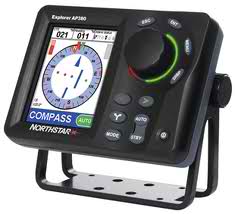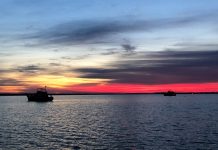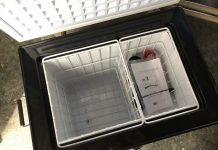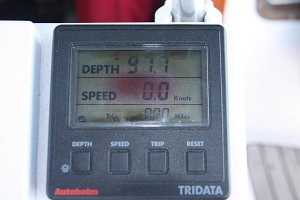The most common complaint we hear on the SSB Nets from boats on passage is that “our self-steering is out and we’re having to hand steer”.
Hand steering a boat on a day hop can be pure pleasure, hand steering a boat alternating two people for three hours at a time for an overnight or longer is torture. Plus as the helmsperson gets tired, it can be just as dangerous as those idiots that link the autopilot to the gps course, go below and assume they’ll arrive in one piece at the other end.
We are so in love with our self-steering devices that they have “people” names and are an active part of Winterlude’s crew. We’re not the only cruisers that name things aboard. We have three self-steering crew members. The autopilot aboard when we bought the boat was named “Boris” in honor of the boat’s prior owner that installed it. The Monitor Windvane is named “Bo” because David says she steers a perfect 10. The new Northstar below-decks autopilot is also named “Boris”, so now we have “Boris Sr” & “Boris Jr”.

When we bought Winterlude, the only autopilot was undersized for our boat, an Autohelm ST4000 “wheel pilot”. This type of autopilot works by an round ring that attaches over the wheel and a small motor connected to a computerized “brain”. On our boat this “brain” is at the helm and is controlled directly at the helm. Unfortunately, we quickly realized this autopilot wasn’t up to anything more than holding a course in flat water, maybe. Couple that with its well-deserved reputation for not being reliable and the fact that it “broke” on us the second real passage we’d ever undertaken, we didn’t feel comfortable relying on it. Our solution, not one we would endorse today, was to carry an entire spare ST4000 unit so if it broke, we’d have spare parts to fix it. Years later, we’ve used all the spare parts and it still works fine. BUT we only use it in flat water, usually to turn the boat into the wind to raise or lower sails. It makes a bit of noise, but nothing compared to the below-decks autopilot.

After significant research, we added a Monitor Windvane as one of our major upgrades prior to leaving the U.S. Our windvane works by serv0-pendulum steering which means there’s an oar to catch the wind and a smaller oar in the water. It attaches to the wheel with lines that turn the wheel which means there are lines coming in from the side, blocking ease of access around one end of the wheel, but it’s well worth it. The Monitor was developed for racing in the Southern Ocean and the advertising says “the harder it blows, the more the Monitor likes it”. But it also works well in lighter air and in fact, we’re even able to use it motorsailing. There are a few points of sail it doesn’t like, primarily dead downwind, but unless the wind is really light, it generally does a good job there too.
Other advantages for the Monitor are significant. The no electricity advantage cannot be underestimated – if we’re on a passage overnight and sailing only, the other autopilots eat significant amounts of juice. Depending on the length of the passage we’d have to run the diesel to recharge if we didn’t have our windvane.
- Works without electricity
- Makes no noise
- Extremely dependable
- Loves heavy weather
Unlike the wheel pilot autopilot, there was a significant learning curve for the windvane. In order for it to work and hold a course, the sails must be balanced perfectly. If it won’t hold a course, it’s generally because of operator error setting the sails. In fact, after using it for years, nowdays when someone is complaining about a windvane not working or not holding a course, we know it’s most likely because they don’t understand sail balance. In fact, I’m not very good at it myself, but David, being a one design racing whiz is very good at balancing the sails perfectly. We practiced a lot when we had the boat on the Chesapeake initially and I can remember even David’s frustration about “this thing doesn’t hold a course” initially. But by the time we left Annapolis to sail to SW Florida, the Monitor was a valued member of the crew.
We left the US with the wheel pilot, Autohelm ST4000, a complete 2nd ST4000 for spare parts and the wonderful Monitor Windvane. We deliberately chose not to link the Autohelm to the GPS even though it had the capability. On our boat, we don’t think it’s safe and we didn’t want to be tempted. Luckily, the windvane steers most of the time, even while we’re motorsailing.

In Bocas Del Toro, Panama, we added a below-decks autopilot, a Northstar with an Explorer SP380 control head. It’s powerful, steering through waves the old autopilot would never tackle. It’s also extremely noisy which is the downside. If the Monitor windvane can’t steer for whatever reason usually not enough wind pressure on the sails motorsailing, Boris Sr takes over. It was an adventure in itself bringing the below-decks autopilot back on an airplane to Bocas Del Toro, Panama! The wooden crate with the guts of the autopilot attracted all kinds of attention. David taped a screwdriver to the exterior of the wooden crate so homeland security/customs could open it up if need be. Unfortunately someone stole the screwdriver before we landed in Panama. Trying to explain to customs officials in Panama entirely in Spanish was definitely a test of my language skills! But finally they put it on the small plane for the flight to Bocas Del Toro.
Damon on s/v Bruadair installed it right there at the dock in Bocas Del Toro and David helped so he knows how it was installed. Unfortunately we had to leave Bocas without the fancy new below decks autopilot, still just the wheelpilot and windvane. And don’t you know we landed our first black fin tuna just outside on our way to the Rio Chagres to meet up with our friends on s/v Kristiana. We needed longer hydraulic hoses and they simply weren’t available around Bocas. So Doug and David searched Colon and with the help of an exceptionally helpful taxi driver, got the stuff we needed. But still we didn’t have it hooked up. When we anchored in Cartagena, Columbia FINALLY David got it all installed, bled the hydraulic lines and on our coastal tour of Columbia, we calibrated it and VOILA! Magic, it works great!
Good thing too – our 5 day passage from Providencia to Port Royal Roatan, that new autopilot, “Boris Sr” made an horrid motorsail better since we didn’t have to be chained to the helm and there wasn’t enough wind for the windvane alot of the time. Same with our passage from Isla to Charlotte Harbor, Florida.
So that’s the self-steering saga. We always double-check all three to make sure they’re functioning properly before we undertake any passage – even if it’s just a day-hop.
We’d like to hear other’s self-steering experiences. Please leave a comment and share! THX! Jan














Agree 100% with the value of the Monitor — but as you say, you have to know how to balance sails. One thing it taught us was to reef early — if we it was blowing and we were having problems, it was usually solved by tucking a reef in!
Belowdecks hydraulic is also fantastic. Loved ours. And the wheel pilot was essentially useless for us, too.
Hi Jan, its been a long time. This is Dave on SV Liberty (Morgan 416). We have the AP380, also installed by Damon, and this old blog post came up on a Google search. I am having screen issues on my AP380 display. In the upper right corner there is a section of grayed out screen (maybe 1/8″ by 1/4″) and when I turned it on for the first time in 6 months I noticed 2 more longer lines in the display, about midway down. (We left the boat for the first time for hurricane season, in St. Maarten). Just curious whether your AP380 screen is having similar issues. Feel free to email me. Thanks much.
WOW! Hi Dave! Great to hear you’re in St Maarten – jealous actually! I’m afraid to say we have no issues with our AP380 display screen — the way the last week has gone, I’m afraid I’ll jinx it. But no, we haven’t experienced anything like that. Have you contacted the manufacturer and maybe e-mailed a photo of the screen problem? Are you out of the country? If so, I’d be glad to try contacting them for you. Let me know! Cheers! Jan
Our Aires is called George. George can be trusted. The Furuno Navpilot is called Bill. It is connected to a computer which reads date from a GPS, Windvane, Fluxgate compass and passes on its wisdom to hydraulic pump that steers the yacht. It cannot be trusted. Bill has a window into the Gates of hell. Like Murphy, it will wait till you are not looking and then the confusion and lies to cover that mess will come in like a flood. Ah, and it is hungry. It needs lots of battery power. It will luff you up, gybe for no reason, break gear and generally cause chaos after lulling you into a false sense of security. Like all politicians and con artists, it has many who will explain its incredibility and insanity away and even blame you for that. we use it, but it gets watched like a naughty child. George. is and old school sailor like us. Simple, honest, forthright and credible. Hey ho George!